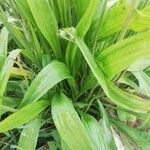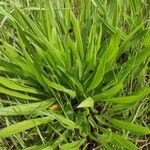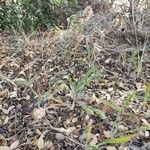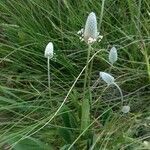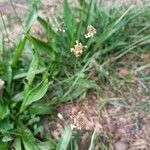Herbs, annual. Taproot long and tenuous, rigid. Stem short, branched basally, internode 2-15 mm, densely white villous-lanate. Leaves spirally alternate, sparsely to densely white villous-lanate; petiole 2-5 cm, tenuous; leaf blade linear to linear-lanceolate, 3-15 cm × 1-6 mm, papery, veins 3, base attenuate and decurrent onto petiole, margin entire or remotely denticulate, apex with 1.5-5 mm subulate tip. Spikes ovoid and 0.5-2 cm at anthesis but narrowly ovoid to shortly cylindric and to 5 cm after anthesis, densely flowered; peduncle 3-22 cm, villous-lanate; bracts broadly ovate to orbicular, 3-4 mm, usually glabrous, keel extending to or near apex. Sepals 2.5-3 mm, keel extending to or near apex; lower sepals obovate-elliptic, glabrous or pubescent; upper sepals elliptic, glabrous. Corolla white, glabrous; lobes orbicular-ovate, 2.5-2.8 mm, patent to reflexed, apex acute. Stamens adnate to near apex of corolla tube, exserted; anthers yellowish brown when dry, ovoid, 0.9-1.3 mm. Pyxis ellipsoid, 4-5 mm, circumscissile near middle, with 2 seeds. Seeds yellowish brown, ellipsoid to ovoid-ellipsoid, 2.5-3 mm, with a groove on ventral face; cotyledons vertical to ventral side. Fl. May-Jun, fr. Jun-Jul. 2n = 8*, 16.
More
Has been cultivated at Kabete, Kenya (Oct. 1934, Hudson in A.D. 2936 !).. It will key to near P. lanceolata in the key below but is not closely related, differing in having 4 free sepals and woolly hairs on the leaves, which are linear or lanceolate.
An annual herb. It grows 5 m high. It has soft hairs. The leaves are in rings. They are narrow and 2-10 cm long by 1-2 mm wide. The fruit capsule is 8 mm long. It contains 2 seeds. These are yellowish brown.
It is a warm temperate and Mediterranean climate plant. It cannot tolerate frost. It grows in areas with an annual rainfall between 80-500 mm. It grows below 1,800 m above sea level. It can grow in arid places.
The husks are used in drinks. The mucilage in the seed coat is used as a stabiliser in ice cream and chocolate manufacture. Sprouted seeds can be eaten in salads, soups and stews. The seeds are mixed with barley grains and processed into flour for flat bread or porridge.
